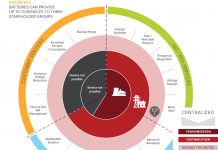John Petersen
Since I discussed dilution risks in emerging energy storage companies last week, today I’m going to shift gears and offer an overview of the opportunities that have developed in larger pure-play energy storage companies since last September. The following graph tracks the 18-month composite performance of the five categories I defined in Battery Investing for Beginners, Part II and shows how they stacked up against the Dow Jones Average.

To understand what’s happened in the storage sector over the last 18 months it’s helpful to remember a few key dates. First, we had the November 2008 crash and the March 2009 retest of the lows. The market started to turn in the spring of 2009 and the storage sector fared better than most because Federal stimulus legislation included billions in direct and indirect subsidies that took final form in August when the President announced $1.25 billion in ARRA battery manufacturing grants. Those grants, in turn, laid the foundation for the successful A123 Systems IPO (AONE) that went off in September. Since September, the euphoria has faded as the market came to grips with the fact that building new factories takes time and changes in the cleantech revolution will be slower than they were in the IT revolution. The market is still adjusting to the reality that storage is governed by a different set of rules, but that adjustment period has created some interesting opportunities for investors who want to position their portfolios for a coming tidal wave of change.
In January of this year I introduced the concept of the Hype Cycle in an article on vehicle electrification and used a graph that TIAX LLC presented at the Plug-in 2008 Conference. I’ve recently found a generic Gartner Group version of the graph that describes the stages of the hype cycle in greater detail.

While opinions on where particular technologies fit on the hype cycle graph vary, I believe a macro-economic trend that’s best described as a “storage supercycle” is just beginning. In IT terms, today is like the late-70s and headline grabbing energy storage applications like plug-in vehicles, frequency regulation and short-duration renewable power integration are analogs of the IBM 5110, the TRS 80 and the Apple II. In effect, the current headliners are little more than timid baby steps in an economic and technical supercycle that will take a couple decades to unfold before reaching its true peak of inflated expectations.
The thing that surprises me most about storage is our profound ignorance of technical, economic and resource limitations. We don’t know whether plug-in vehicles will satisfy mainstream transportation needs because except for a couple of small-scale tests, nobody’s built a fleet of plug-in vehicles, put them into the hands of ordinary people, and operated them long enough to find out. We don’t know whether lithium-ion battery packs will perform as well in practice as they do in computer simulations and we can’t know whether any of the promised economies of scale will actually materialize. For that matter, we’re not entirely certain that global raw material supply chains will be up to the task. At the end of the day it’s an R&D project that may work out well, but may also prove once again that batteries are not cost effective replacements for fuel tanks.
The same dynamic holds for ongoing efforts to use flywheels and a variety of other technologies to regulate the power grid and smooth the output of windmills. The first goal is to find out whether the various technologies are robust enough to do the required work for a reasonable service life. Once technical feasibility is established, the more difficult and demanding task will be identifying applications and installations where the benefits justify the costs. The process has started, but it will be years before the reports are written and wide-scale implementation decisions begin.
Over the next decade I expect all of today’s leading technological contenders to be eclipsed by new developments. Some will be improvements on old-line chemistries, others will be improvements on advanced chemistries, and others still will take gee-whiz science out of research laboratories and move it into factories. The end result will be a crazy quilt where a wide variety of storage technologies will dominate billion dollar market segments, but no technology will dominate the industry. Tolkien is not writing this story and we’re never going to see “one ring to rule them all.”
Cheap Sustainable Companies
My cheap sustainable category, which includes Enersys (ENS), Exide Technologies (XIDE), C&D Technologies (CHP) and Active Power (ACPW), has been the hands down winner in terms of composite performance, but is off significantly from last fall’s peak. When you consider the price trends for the individual companies, it becomes clear that Enersys was the star performer while the other three were relative laggards.

Some key valuation metrics as reported by Yahoo! Finance are in the following table.

Exide is emerging from a major restructuring that crushed earnings and drove its price down to roughly 25% of the pre-crash high of $18.80 per share. C&D has recently completed a big construction project in China that drove its stock price down to roughly 11% of the pre-crash high of $9.05 per share. Both are trading at prices that are very close to book value and represent obscenely low multiples of sales. They’re also emerging from difficult times into a rapidly changing market that’s demanding better performance and should favor their high-end product lines. In my view both Exide and C&D could easily double or triple over the next twelve months as the accomplishments of the last few years begin to show up in reported operating results.
Active Power is a textbook example of how a hot IPO can wallow for years if technological and business developments
take longer and cost more than the market expects. After starting from an adjusted IPO price of over $70, it faded to an all time low of $0.26 in the winter of 2008. Since then, its flywheel-based power quality systems have gained traction in the data center market and just last week it announced an $8 million order, or roughly 25% of its 2009 sales. It seems that Active Power has finally found its footing after a lost decade of disappointment. If its business continues to follow the trajectory established over the last 18 months, it should be a solid performer in the coming year and could easily double or triple.
Chinese Companies
My Chinese category, which includes Advanced Battery Technology (ABAT), China BAK Battery (CBAK), China Ritar Power (CRTP) and Hong Kong Highpower (HPJ), has also been a solid performer that’s trading way off its peak from last fall. When you consider the price trends for the individual companies, it becomes clear that CRTP and ABAT were the star performers, HPJ did well, and CBAK was the only true laggard.

Some key valuation metrics as reported by Yahoo! Finance are in the following table.

My two favorites in this category are ABAT, which is pursuing a vertical integration strategy in the booming electric two-wheeled vehicle market, and CRTP, which is a major manufacturer of cheap lead-acid batteries. While Hong Kong Highpower has been a solid performer and is down by 50% from its recent high, most of its sales come from NiMH batteries that require the rare earth metal Lanthanum. Given uncertainties over rare earth metal supplies, I worry that HPJ may face significant resource constraint issues over the next few years. While CBAK is one of the largest lithium-ion battery manufacturers on the planet and has a world class customer list, its financial results highlight a nagging concern that great customer lists aren’t always good things if the customers are so tight fisted that you can’t earn a decent gross profit.
Cool Sustainable Companies
My cool sustainable category includes A123 Systems, Maxwell Technologies (MXWL) and Ultralife (ULBI). While Maxwell has been a solid performer, Ultralife has trended downward since I started following it and A123 is currently trading for about 75% of its $13.50 IPO price after a run into the mid-$20s.
![]()
Some key valuation metrics as reported by Yahoo! Finance are in the following table.
![]()
Of the cool sustainable companies my favorite is Ultralife because it has a history of profitability, trades at 1x book value and 45% of sales, and has been beaten down by almost two-thirds from its peak in December 2008. I expect Maxwell to perform well over the next year, but think reasonable performance expectations are already priced into the stock. A123 worries me a bit because market expectations for plug-in vehicles are so high and it will be hard for any lithium-ion battery manufacturer to live up to those unreasonable expectations.
Conclusion
These are times of immense risk and once in a lifetime opportunity. Unless you’re an expert, the only rational way to invest in the energy storage sector is with a diversified portfolio that focuses on a relatively short time horizon and leaves room to adapt to rapidly changing conditions. All other roads lead to the technology du jour minefields that have been snaring the unwary for as long as I’ve been practicing law:
| 25 years ago | Methanol |
| 15 years ago | Electric Vehicles |
| 10 years ago | HEVs and Electric Vehicles |
| 5 years ago | Hydrogen Fuel Cells |
| 3 years ago | Ethanol and Biofuels |
| Today | PHEVs and Electric Vehicles |
| 2012 | The next big thing? |
Disclosure: No positions.







